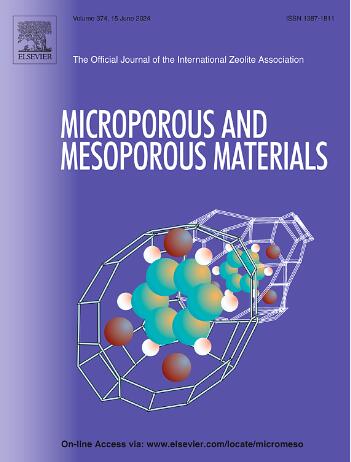Learning descriptors to predict organic structure-directing agent applicability in zeolite synthesis
IF 4.8
3区 材料科学
Q1 CHEMISTRY, APPLIED
引用次数: 0
Abstract
Zeolite synthesis frequently relies on organic structure-directing agents (OSDAs), but the process of identifying the best OSDA to synthesize a given zeolite remains difficult. We use previously gathered binding energy data, in additional to the formation energies of the siliceous zeolite frameworks and approximate binding entropies of OSDAs to develop new descriptors to improve predictions based on known OSDA-zeolite pairs in the literature. Our earlier work used templating energy () to rank the most likely OSDA-zeolite pairs to be produced from synthesis. Using literature recall area-under-the-curve (AUC) as a performance metric, we find that computing energies associated with the net transformation that occurs during zeolite synthesis (the sum of the formation energy of the zeolite framework and the OSDA binding energy) provides a modest improvement over when predicting the zeolite phase that a given OSDA produces, from 67.5% average literature recall to 72.3%, but negligibly improves predictions for the best OSDA for a given zeolite framework, from 68.3% to 68.8%. We then use machine learning symbolic regression to develop a new descriptor, which we call , that slightly improves upon for predicting an OSDA for a given framework, with an average literature recall of 71.8%. While zeolite synthesis remains difficult to predict a priori, the approaches used in this work provide one option for improving these predictions.

求助全文
约1分钟内获得全文
求助全文
来源期刊

Microporous and Mesoporous Materials
化学-材料科学:综合
CiteScore
10.70
自引率
5.80%
发文量
649
审稿时长
26 days
期刊介绍:
Microporous and Mesoporous Materials covers novel and significant aspects of porous solids classified as either microporous (pore size up to 2 nm) or mesoporous (pore size 2 to 50 nm). The porosity should have a specific impact on the material properties or application. Typical examples are zeolites and zeolite-like materials, pillared materials, clathrasils and clathrates, carbon molecular sieves, ordered mesoporous materials, organic/inorganic porous hybrid materials, or porous metal oxides. Both natural and synthetic porous materials are within the scope of the journal.
Topics which are particularly of interest include:
All aspects of natural microporous and mesoporous solids
The synthesis of crystalline or amorphous porous materials
The physico-chemical characterization of microporous and mesoporous solids, especially spectroscopic and microscopic
The modification of microporous and mesoporous solids, for example by ion exchange or solid-state reactions
All topics related to diffusion of mobile species in the pores of microporous and mesoporous materials
Adsorption (and other separation techniques) using microporous or mesoporous adsorbents
Catalysis by microporous and mesoporous materials
Host/guest interactions
Theoretical chemistry and modelling of host/guest interactions
All topics related to the application of microporous and mesoporous materials in industrial catalysis, separation technology, environmental protection, electrochemistry, membranes, sensors, optical devices, etc.
 求助内容:
求助内容: 应助结果提醒方式:
应助结果提醒方式:


